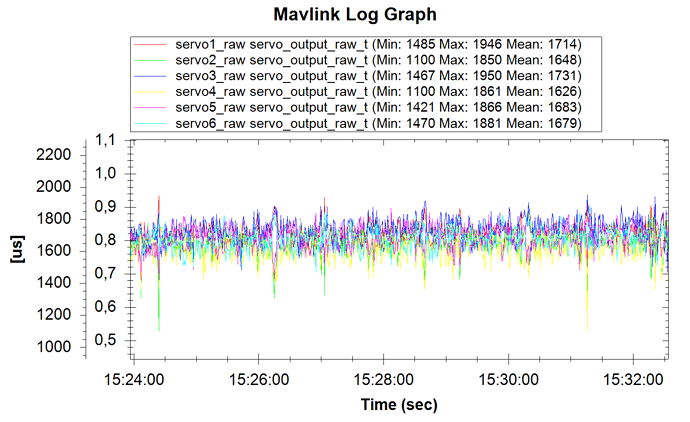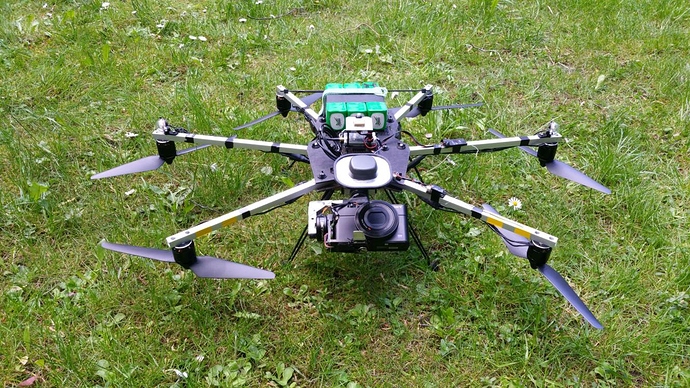Not really sure here but shouldn’t be the arms placed as supposed in a hexa aircraft? It looks like yours are not equally spaced around, the front ones being at a steeper angle than the rear. I am not sure but i think the system expects a certain level of momentum from each motor and having different lenghts throws all of this off.
could I mitigate that problem by converting it into a x8v by eliminiating arm 2 and 5?
I think the arms need to be placed as expected in the arm configuration you choose.
Hi guys, I wanted to thank you, I think I fixed the major problem by replacing the arms. Not perfekt but good enough to go rescuing fawns at the end of the week.
2019-05-13 15-20-50.zip (839.4 KB)
I built one with a very similar arm layout. I had trouble with motor throttles and strange random crashing, particularly in windy conditions. I eventually gave up on the airframe. All the components worked fine a plain old X frame quad.
I still think you should arrange your arms in a “supported” pattern.
Years ago, maybe 6-7, on a MikroKopter forum there was an efficiency comparison test between a normal and an upside-down mounted motor, and there was a 15% loss from mounting it upside-down. The gain was in less vibrations from airflow hitting the square arms as each blade went by, creating jello on the footage.
@ThePara are you sure? Where should that loss come from?
@Corrado_Steri you might be right. But I want to try anyhow. I did review most of the special occurences during the last year and could clearly see that it was due to the missing rpm headroom (it would be good if the copter would sacrifice yaw authority for altitude authority below the rtl rtl altitude). Even if there was a serious handycap my copter did survive for more than 1750 ha. Now the handycap is probably gone or reduced by 70%.
I want to try autotune and rewiew the pwm behaviour of each motor. I’m expecting to reduce the difference to below 50 pwm. The test flight was hovering in windy conditions (I did not check the direction unfortunately) with the old pid values. I hope that the problem will go away and I will report.
@GFChr I’m not that negative about the quad, if the direction relatve to the wind was ideal it did fly perfect in windy conditions  . I think it is possible and I will try. Anyhow I’m building a quad (V shaped again
. I think it is possible and I will try. Anyhow I’m building a quad (V shaped again 

 ) and keep this one as backup.
) and keep this one as backup.
1750 ha ? That’s three days work if I’m lazy. You need better then 2.5 cm/pixel ?
I guess it is if it is in summer, in one piece and at one time. I’m doing between 0.9 and 3 cm/px and many sites.
But of course, I’m a beginner, I’m doing that in my spare time and I’m learning it myself. It was my first year, so what. This year I’m going to concentrate on fawn and bird rescue - I do not need to be the pro but I want to do something that matters.
@ThePara by the way, where are you doing your maping?
@ThePara could you provide some more insight and arguments? I find it hard to imagine why there should be any loss. The only thing is the motor friction but I think that there is no difference since the bearings have no mounting direction and the motor should be floating within the magned field anyhow.
From a fluid dynamic point of view it is much worse to have an obstruction where the pressure is low vs where is high. You have your motor and arm obstructing the inlet to the prop at low pressure and that is where you loose efficiency.
On top of that your air when entering the prop is not clean but it is full of vortexes due to the air going around motor and arms wich are not aerodynamic, so the prop works with perturbated air and is loosing efficiency.
An Experimental Investigation of Tractor and Pusher Hexacopter Performance
Results show the pusher con- figuration generates approximately 15% more thrust (lift) than do tractor propellers, however exhibit relatively poor lift to drag ratio. These results suggests that a pusher configuration will have higher efficiency for local-area surveillance applications requiring hover and slow flight, whereas a tractor configuration is more efficient for payload transport applications.
I think that shows that there is a trade-off which needs to be considered. Thank you, I think I will reconsider this for my next build.
I did now try to autotune my copter. One axis atime. While the yaw axis worked well, I get very strange results with the other axis. The stabilize pitch and roll values are extreamly low (<0.1) and while the vehicle flies well with the new values while still in the air after tuning it flips (due to the low value) at the next start.
Looking at your build (wooden arms, cracked left front arm), it may well be that it is to flexible to get a good result from autotune. I had that issue with the flexible plastic arms from rctimer (s800) that autotune does not give proper value (very low stab p values).
Arrange your arms in a proper way (as said before), check your weight distribution and all your probs will disappear.

